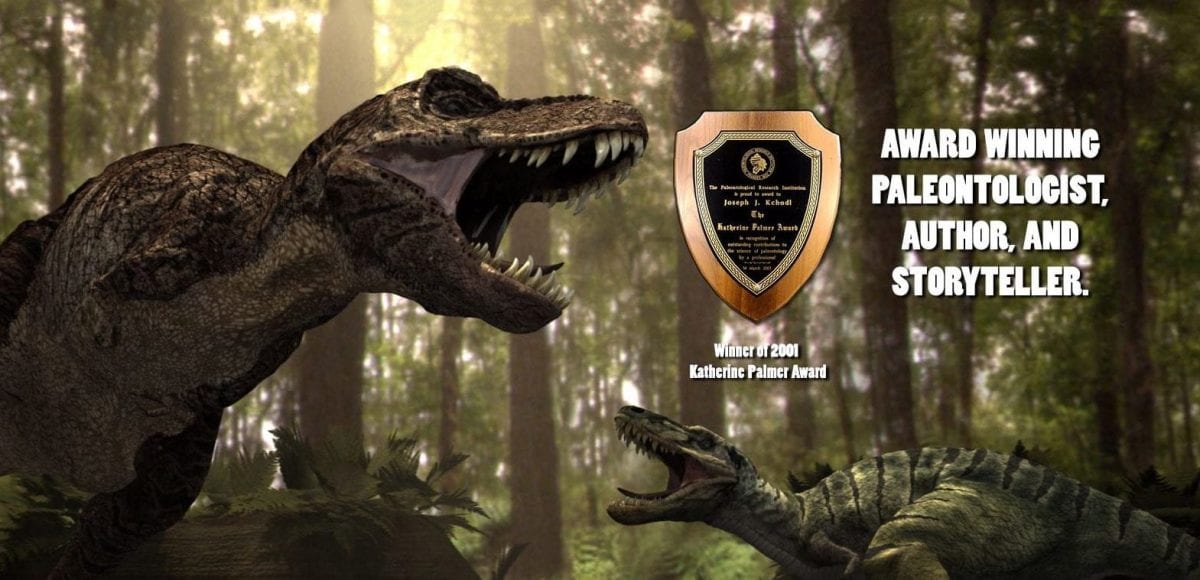
fun School Assemblies & Classes
K – 12 programs available. Age appropriate Educational, exciting, and entertaining dinosaur programs.
Winner of the 2021 Charles H. Sternberg Medal

Educational Programs
fossil digs
Exhibits
THE FOSSIL STORE
TRILOBITE OF THE WEEK
Trilobite of the Week: ALBERTELLA longwelli
By Joseph "PaleoJoe" Kchodl The Cambrian trilobite ALBERTELLA longwelli has a very small pygidium or tail section, but it ends with two very long, rearward-pointing spines. It has a wide cephalon that ends in long, outwardly-pointing spines. The third thoracic segment...
Trilobite of the Week: CERAURUS pleurexanthemus
By Joseph "PaleoJoe" Kchodl There are many species of CERAURUS trilobites around the world, including Canada and the United States. Each species has subtle differences. This CERAURUS pleurexanthemus specimen comes from Trenton Falls, New York. It averaged around one...
Trilobite of the Week: HOMOTELUS bromidensis
The Ordovician trilobite HOMOTELUS bromidensis is often found in mass death assemblages. It is theorized that they perished due to a catastrophic event during the mating period. Today, modern horseshoe crabs gather by the tens of thousands for mating....
Trilobite of the Week: HEMIRHODON amplypyge
HEMIRHODON amplypyge is a Cambrian trilobite that is roughly oval shaped, and it is very broad and flat. The Cephalon or head section is roughly semi-circular. The cephalon and pygidium are, again, broad and flat. The axial lobe is thinner than the pleural lobes. It...
Trilobite of the Week: OLENELLUS fowleri
By Joseph "PaleoJoe" Kchodl OLENELLUS fowleri is almost circular in shape. Its cephalon or head section is very large and broad and is the distinguishing feature of this trilobite. It is very highly ornamented with many rearward projecting spines. The eyes are set...
Trilobite of the Week: CRYPTOLITHUS ulrichi
By Joseph "PaleoJoe" Kchodl CRYPTOLITHUS ulrichi has a very broad Cephalon bordered by a wide “brim,” which has a large number of pits or holes. It has been theorized that this trilobite was a filter feeder and that the wide brim and pits assisted in feeding. The...
Trilobite of the Week: BUMASTIS ioxus
By Joseph "PaleoJoe" Kchodl The BUMASTIS ioxus trilobite was found in the United States during the digging of the Erie Canal. It was first discovered in 1839 in a gorge dug for the canal. Being roughly oval in shape, it is difficult to judge which is the Cephalon and...
Trilobite of the Week: MODOCIA brevispina
One of the more rare MODOCIA species, the name makes an apt description. Other MODOCIA have large genal spines, and this species does not. It has small spines; hence, the term brevispina. This trilobite is roughly oval in shape and has a semi-circular cephalon, or...
Trilobite of the Week: GREENOPS boothi
By Joseph "PaleoJoe" Kchodl GREENOPS boothi can be found in several parts of Michigan, New York, and Ontario, Canada. This Devonian trilobite is very showy with all the spikes and spines it has on its body. The long and broad genal spines help us to identify it....
Trilobite of the Week: CYPHASPIS carrolli
By Joseph "PaleoJoe" Kchodl CYPHASPIS carrolli is a rare and spectacular trilobite. Found in the Haragan Formation in Coal County, Oklahoma, it is a recent addition to the body of scientific knowledge about trilobites. Trilobite paleontologist Robert Carroll...
Trilobite of the Week: CEDARIA minor
By Joseph "PaleoJoe" Kchodl This is a cute but small oval-shaped trilobite. Typically, CEDARIA minor measures 3/8 inches long. It has a smooth glabella and Cephalon with a medium profile, making it not too tall or inflated. The Cephalon ends in medium-length genal...
Trilobite of the Week: PERONOPSIS interstricta
By Joseph "PaleoJoe" Kchodl The PERONOPSIS interstricta were small, blind trilobites that were isopygious, meaning the head section and the tail section were roughly the same size. In fact, at first glance, one cannot determine which end is the front and which is the...
Trilobite of the Week: UTASPIS marjumensis
The trilobite pictured is lying atop a small bryozoan branch. It would be very difficult to remove the branch without damage to this very fine UTASPIS This trilobite is one of the Cambrian trilobites commonly found in the House Range of Millard County, Utah, which is...
Trilobite of the Week: TRIMURUS delphinocephalus
By Joseph "PaleoJoe" Kchodl One of the largest species of trilobite found in New York State, TRIMURUS delphinocephalus is a prize in anyone’s collection. The digging of the Erie Canal in the 1800s produced some very interesting finds to the diggers. The TRIMURUS has a...
Trilobite of the Week: PSEUDODECHANELLA rowi
By Joseph "PaleoJoe" Kchodl Presented here is PSEUDODECHANELLA rowi, a beautiful and deep black-colored trilobite from the Devonian Period of New York. This stout trilobite has a very inflated and semi-circular head section. With very large crescent-shaped eyes, its...
Trilobite of the Week: MAUROTARIAN axitiosum
By Joseph "PaleoJoe" Kchodl MAUROTARIAN axitiosum is a Devonian trilobite from the famous Haragan Formation of Coal County, Oklahoma. This area is well known for the cream colored matrix and the caramel colored calcite the trilobites are preserved as. The preservation...
Unusual shape: MODOCIA typicalis
By Joseph "PaleoJoe" Kchodl There are many species of MODOCIA, and this one typicalis, or typical, is quite common in the Cambrian deposits of Millard County, Utah. This trilobite is the most famous and showy of the MODOCIA trilobites. It is generally oval in shape,...
Captivating Fossil: CALYMENE breviceps
By Joseph “PaleoJoe” Kchodl This species of Silurian CALYMENE has a very bulbous and furrowed glabella. The trilobite is roughly triangular in shape with the cephalon that is roughly semi–circular in shape. This trilobite is fairly broad and has a small pygidium. The...
COMPTONASPIS swallowi: Plain Design And End of a Reign
By Joseph "PaleoJoe" Kchodl The COMPTONASPIS swallowi species is another trilobite appearing at the end of the reign of trilobites. There was a catastrophic event at the end of the Permian period, which resulted in the trilobites being wiped out. This Mississippian...
Molting and Moving — BATHYURISCUS fimbriatus Trilobite
By Joseph "PaleoJoe" Kchodl This Cambrian trilobite is found in the Wheeler formation of Delta County, Utah. Interestingly, it is quite uncommon to find this trilobite with free cheeks attached. Most examples appear as discarded molt because, with a hard exoskeleton,...
CALYMENE niagarensis Carries Commonality to Unique Localities
By Joseph "PaleoJoe" Kchodl CALYMENE niagarensis is a very common Silurian trilobite found in the Rochester Shale. The trilobite is roughly triangular with a cephalon that is roughly semi-circular in shape. This trilobite is fairly broad, has a small pygidium, and...
Trilobite Hunting Grand Find: OLENELLUS fremonti
By Joseph "PaleoJoe" Kchodl Nevada is known for its grand casinos, but for trilobite hunters, it is known for grand Cambrian trilobites. Equally grand, in terms of trilobite size, is the Nevada native OLENELLUS fremontii. This type of trilobite is known to grow up to...
ZACANTHOIDES idahoensis — A Predatory Carnivore
By Joseph "PaleoJoe" Kchodl The featured fossil, a ZACANTHOIDES idahoensis, is a very spiny Cambrian trilobite with a wide cephalon that ends in long genal spines. The thorax is slender and contains nine segments and two pleural lobe sections that end in very long...
Oklahoma Trilobite Is Small in Size, But Big in Ornamentation
By Joseph "PaleoJoe" Kchodl The KETTNERASPIS williamsi is a small but highly ornamented trilobite. Very broad and wide this trilobite has long spines, and was initially named LEONASPIS williamsi. The eyes are set high on the cephalon, and the cephalon ends in two very...
Oklahoma Delivers Plentiful and Beautiful Trilobites
By Joseph "PaleoJoe" Kchodl Oklahoma is considered by some to be the best location for the best preservation of trilobites of the Devonian in the U.S. One specific location provides most if not all of the Devonian Haragan Formation Oklahoma bugs found for sale in rock...
Trilobite Body Size Doesn’t Always Determine Spine Size
By Joseph "PaleoJoe" Kchodl The BELLACARTWRIGHTTIA whitelyi is a seldom-seen trilobite. As you may be well aware, trilobites are an extinct form of arthropod related to insects, crabs, crayfish, and horseshoe crabs. These creatures are called trilobite due to the...
Trilobite of the Week: Snout and spine help distinguish Huntonia Linguifer
By Joseph "PaleoJoe" Kchodl Did you know trilobite get their name from the three distinct “lobes” running vertically through their body section? In this week’s trilobite review, we're looking at the HUNTONIA linguifer. This trilobite is very similar in size and shape...
CALYMENE celebra — The Pride of Wisconsin Fossils
By Joseph “PaleoJoe” Kchodl The common Silurian trilobite, CALYMENE celebra, is easy to identify, mostly because of the rock it is found in, the color, and excellent preservation. It is the State Fossil of Wisconsin. These trilobites are found in the Niagaran...
Trilobite Reveals Lead Up to Extinction
By Joseph “Paleo Joe” Kchodl As you may be well aware, trilobites are an extinct form of arthropod related to insects, crabs, crayfish, and horseshoe crabs. These creatures are called trilobite due to the three distinct “lobes” running vertically through the body...
Oklahoma’s Ornamented Trilobite
By Joseph "Paleo Joe" Kchodl DICRANURUS elegantus is a very highly ornamented spiny Devonian trilobite species. It has very long and flowing genal, thoracic and pygidial spines. Preparation of this trilobite preserved in limestone is very painstaking and time...
Trilobite Tuesday: An Erie Canal Connection
By Joseph "PaleoJoe" Kchodl ARCTINURUS boltoni is a well known and dramatic trilobite found in the Silurian deposits of New York State. During the digging of the Erie Canal in the 1820’s, these trilobites were a unique find. Trilobites are an extinct form of arthropod...
Trilobite Tuesday: Eldredgeops rana
By Joseph "PaleoJoe" Kchodl As you may be well aware, trilobites are an extinct form of arthropod related to insects, crabs, crayfish and horseshoe crabs. These creatures are called trilobite due to the three distinct “lobes” running vertically through the body...
Trilobite Tuesday: Triarthrus
By Joseph "PaleoJoe" Kchodl Trilobites are an extinct form of arthropod related to insects, crabs, crayfish and horseshoe crabs. These creatures are called trilobite due to the three distinct “lobes” running vertically through the body section. Arguably one of the...
Trilobite Thursday: Asaphiscus wheeleri
By Joseph "PaleoJoe" Kchodl As you may be well aware, trilobites are an extinct form of arthropod related to insects, crabs, crayfish and horseshoe crabs. These creatures are called trilobite due to the three distinct “lobes” running vertically through the body...
Trilobite Tuesday: What is a trilobite?
Trilobites are an extinct form of arthropod related to insects, crabs, crayfish and horseshoe crabs. These creatures are called trilobite due to the three distinct “lobes” running vertically through the body section. There is a central or “axial” lobe and two pleural...
Fossil of the Month September Knightia
Knightia is a species of fish found in the Green river Formation of Wyoming. The rock splits cleanly along bedding planes revealing the exquisitely preserved fish, usually NO cleaning required.
Fossil of the Month of May Hexagonaria, The Petoskey Stone
The Petoskey Stone is the State Stone of Michigan. But it is not a Petoskey until it is polished. In it's natural form it is actually a fossilized colonial coral called hexagonaria. There are several types of the Hex. Many are found along the shores of Lake Michigan...
Fossil of the Month March Gastropods
Gastropods commonly called Snails. This is a great example of a Silurian snail from the Rochester Shale formation. Gastropods belong to the phylum Mollusca. The class of fossil Gastropoda in my collection is comprised of snails from saltwater. I have not yet found any...
Fossil of the Month February Cystoid
Cystoids were animals that lived in the shallow salt water seas. This one is from the famous Rochester Shale of Middleport New York. It is Silurian in age. The Cystoid is made up of a "stem" using a "holdfast" to attach itself to a rock or bryozoan. At the top of the...
Fossil of the Month January Brachiopods
Brachiopods have a hard external shell that is comprised of two asymmetrical halves called valves. The pedicle valve generally has a hole in it where the pedical or a stalk like structure like a "foot" comes out. Each half of the brachiopod shell has a slightly...












